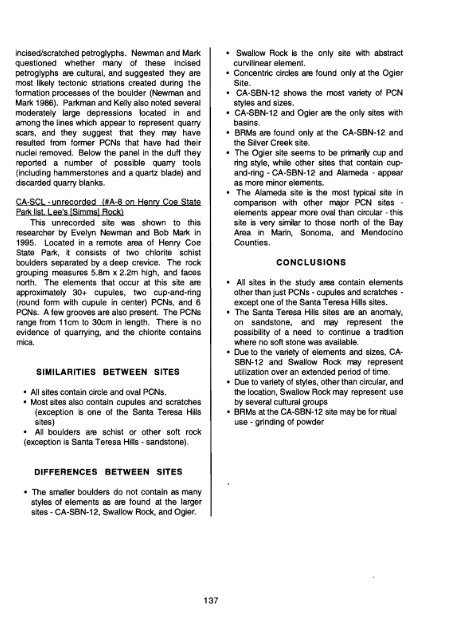a stylistic analysis of the rock art of ca-sbn-12 - Society for California ...
a stylistic analysis of the rock art of ca-sbn-12 - Society for California ...
a stylistic analysis of the rock art of ca-sbn-12 - Society for California ...
You also want an ePaper? Increase the reach of your titles
YUMPU automatically turns print PDFs into web optimized ePapers that Google loves.
incised/scratched petroglyphs. Newman and Mark<br />
questioned whe<strong>the</strong>r many <strong>of</strong> <strong>the</strong>se incised<br />
petroglyphs are cultural, and suggested <strong>the</strong>y are<br />
most likely tectonic striations created during <strong>the</strong><br />
<strong>for</strong>mation processes <strong>of</strong> <strong>the</strong> boulder (Newman and<br />
Mark 1986). Parkman and KeJly also noted several<br />
moderately large depressions lo<strong>ca</strong>ted in and<br />
among <strong>the</strong> lines which appear to represent quarry<br />
s<strong>ca</strong>rs, and <strong>the</strong>y suggest that <strong>the</strong>y may have<br />
resulted from <strong>for</strong>mer PCNs that have had <strong>the</strong>ir<br />
nuclei removed. Below <strong>the</strong> panel in <strong>the</strong> duff <strong>the</strong>y<br />
reported a number <strong>of</strong> possible quarry tools<br />
(including hammerstones and a qu<strong>art</strong>z blade) and<br />
dis<strong>ca</strong>rded quarry blanks.<br />
CA-SCL - unrecorded (#A-8 on Henry Coe State<br />
Park list. Lee's [Simms] Rock)<br />
This unrecorded site was shown to this<br />
researcher by Evelyn Newman and Bob Mark in<br />
1995. Lo<strong>ca</strong>ted in a remote area <strong>of</strong> Henry Coe<br />
State Park, it consists <strong>of</strong> two chlorite schist<br />
boulders separated by a deep crevice. The <strong>rock</strong><br />
grouping measures 5.8m x 2.2m high, and faces<br />
north. The elements that occur at this site are<br />
approximately 30+ cupules, two cup-and-ring<br />
(round <strong>for</strong>m with cupule in center) PCNs, and 6<br />
PCNs. A few grooves are also present. The PCNs<br />
range from 11cm to 30cm in length. There is no<br />
evidence <strong>of</strong> quarrying, and <strong>the</strong> chlorite contains<br />
mi<strong>ca</strong>.<br />
SIMILARITIES BETWEEN SITES<br />
• All sites contain circle and oval PCNs.<br />
• Most sites also contain cupules and scratches<br />
(exception is one <strong>of</strong> <strong>the</strong> Santa Teresa Hills<br />
Sites)<br />
• All boulders are schist or o<strong>the</strong>r s<strong>of</strong>t <strong>rock</strong><br />
(exception is Santa Teresa Hills - sandstone).<br />
• Swallow Rock is <strong>the</strong> only site with abstract<br />
curvilinear element.<br />
• Concentric circles are found only at <strong>the</strong> Ogier<br />
Site.<br />
• CA-SBN-<strong>12</strong> shows <strong>the</strong> most variety <strong>of</strong> PCN<br />
styles and sizes.<br />
• CA-SBN-<strong>12</strong> and Ogier are <strong>the</strong> only sites with<br />
basins.<br />
• BRMs are found only at <strong>the</strong> CA-SBN-<strong>12</strong> and<br />
<strong>the</strong> Silver Creek site.<br />
• The Ogier site seems to be primarily cup and<br />
ring style, while o<strong>the</strong>r sites that contain cupand-ring<br />
- CA-SBN-<strong>12</strong> and Alameda - appear<br />
as more minor elements.<br />
• The Alameda site is <strong>the</strong> most typi<strong>ca</strong>l site in<br />
comparison with o<strong>the</strong>r major PCN sites <br />
elements appear more oval than circular - this<br />
site is very similar to those north <strong>of</strong> <strong>the</strong> Bay<br />
Area in Marin, Sonoma, and Mendocino<br />
Counties.<br />
CONCLUSIONS<br />
• All sites in <strong>the</strong> study area contain elements<br />
o<strong>the</strong>r than just PCNs - cupules and scratches <br />
except one <strong>of</strong> <strong>the</strong> Santa Teresa Hills sites.<br />
• The Santa Teresa Hills sites are an anomaly,<br />
on sandstone, and may represent <strong>the</strong><br />
possibility <strong>of</strong> a need to continue a tradition<br />
where no s<strong>of</strong>t stone was available.<br />
• Due to <strong>the</strong> variety <strong>of</strong> elements and sizes, CA<br />
SBN-<strong>12</strong> and Swallow Rock may represent<br />
utilization over an extended period <strong>of</strong> time.<br />
• Due to variety <strong>of</strong> styles, o<strong>the</strong>r than circular, and<br />
<strong>the</strong> lo<strong>ca</strong>tion, Swallow Rock may represent use<br />
by several cultural groups<br />
• BRMs at <strong>the</strong> CA-SBN-<strong>12</strong> site may be <strong>for</strong> ritual<br />
use - grinding <strong>of</strong> powder<br />
DIFFERENCES BETWEEN SITES<br />
• The smaller boulders do not contain as many<br />
styles <strong>of</strong> elements as are found at <strong>the</strong> larger<br />
sites - CA-SBN-<strong>12</strong>, Swallow Rock, and Ogier .<br />
137
















